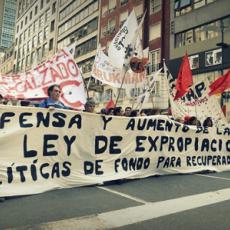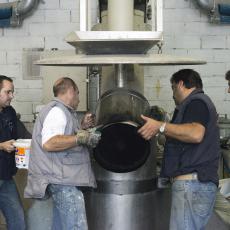Why Unions Are Going Into the Co-op Business
As manufacturing in the United States continues in free fall, the USW aims to use employee-run businesses to create new jobs to replace union work that has gone overseas.
“Too often we have seen Wall Street hollow out companies by draining their cash and assets and hollow out communities by shedding jobs and shuttering plants,” said United Steelworkers (USW) President Leo Gerard in 2009. “We need a new business model that invests in workers and invests in communities.”
Gerard was announcing a formal partnership between his 1.2-million-member union and Mondragon, a cluster of cooperatives in the Basque region of Spain.
Mondragon employs 83,000 workers in 256 companies. About half of those companies are cooperatives, and about a third of Mondragon’s employees are co-op members with an ownership stake in their workplace. Mondragon companies do everything from manufacturing industrial machine parts to making pressure cookers and home appliances to running a bank and a chain of supermarkets. With billions of euros in annual sales, Mondragon is the largest industrial conglomerate in the Basque region and the fifth-largest in Spain.
The cooperatives use workers’ cash investments as part of the capital needed to finance new projects, and worker-owner co-op members get to vote on strategy, management, and business planning. The highest-paid managers’ salaries are capped at six to eight times what the lowest-paid workers make—as opposed to the United States, where CEOs now make 380 times more than the average worker.
Building union co-ops
As manufacturing in the United States continues in free fall, the USW is working to bring the Mondragon cooperative model to the Rust Belt. It aims to use employee-run businesses to create new, middle-class jobs to replace union work that has gone overseas.
A March 2012 report from the USW, Mondragon, and the Ohio Employee Ownership Center (OEOC), lays out a template for how “union co-ops” can function. “A union co-op is a unionized worker-owned cooperative in which worker-owners all own an equal share of the business and have an equal vote in overseeing the business,” the report states.
But how do union co-ops differ from traditional worker-owned co-ops? The report explains that the key difference is that workers in a union co-op can appoint a management team (from within their own ranks or from outside the co-op) and then bargain collectively with management. The resulting collective bargaining agreements can set wage rates for all the co-op’s jobs, choose health care and other benefit packages, decide how workers will earn time off, and determine a process for grievances and arbitration of workplace disputes.
In addition to producing the union co-op template, the USW has worked to get pilot cooperatives started in the United States. The union has carefully examined the Evergreen Cooperatives, which were started in Cleveland in 2009 with a blend of foundation money, public funds, and private investment capital. Drawing from Mondragon’s principles of shared prosperity for workers and democratic governance, Evergreen launched a commercial laundry that now cleans more than four million pounds of laundry per year and employs 30 people. It also has plans for a solar installers’ cooperative and a greenhouse that grows high-end salad greens and herbs for the Cleveland Clinic, as well as universities and restaurants. The example was an important one for the USW’s pilot projects, suggesting a blueprint to keep jobs local, tie new businesses to existing city institutions, and give workers a voice in company operations.
OEOC Director Bill McIntyre worked with the Cleveland Foundation on crafting the organizational framework for the Evergreen Cooperatives. At a March 2012 press event at United Steelworkers headquarters, he observed that employee-owners more often kept their jobs during the recent economic meltdown. “Employee-owned companies,” he said, “have more stable, loyal, and experienced work forces, which translates into real cost savings, productivity, and quality advantages.”
Reviving a Pittsburgh laundry
A group of unions, including the USW, is helping to launch the Pittsburgh Clean and Green Laundry Cooperative, a new industrial laundry. Several years ago, a local laundry closed, leaving more than 100 people without work. Together with the USW, the workers began exploring the idea of creating a cooperative to take over the business. The union has now completed a feasibility study for the business and is lining up commitments from clients such as local hospitals and clinics. A full laundry plant is scheduled to be up and running soon, thanks in part to the support of the Steel Valley Authority (SVA)—Pennsylvania’s publicly funded initiative for saving and creating industrial jobs—and other local foundations.
“Right now, several of the larger hospitals are sending their laundry out pretty far to get it done, so [going local] makes sense cost-wise, and it makes sense green-wise,” says Rob Witherell, the USW’s cooperative organizer and strategist.
“The intent is that the folks who worked at the previous laundry would be the first to join as worker-owners,” Witherell adds.
Under the union-cooperative model, the laundry’s employees would be able to join the union of their choice, and the jobs offered at the plant would provide a living wage, benefits, and a collective bargaining agreement. As worker-owners, the employees would also gain equity in the business.
“The way it works in Cleveland is the folks working at the laundry—if they’re to become owners—have their initial ownership investment financed by the company,” explains Witherell. “Fifty cents an hour is deducted from their wages for a period of three years, until they have met the requirements for ownership.”
Worker-owners vote on decisions about the management of the company. And, as in Mondragon, a share of profits is added to the ownership accounts, so that long-term workers can retire or leave the company having accrued a significant stake. “In Cleveland, they’ve done the math, and they’ve figured out that in eight years—if they meet their business targets, which they have so far—those folks will each have $65,000 in their ownership accounts,” Witherell says.
For the SVA, the model is one it hopes to spread further: It has announced a goal of establishing a technical assistance center and a revolving loan fund to help worker groups that want to use the Mondragon model.
Cooperative harvest in Cincinnati
In the past year, the USW has supported work to create the Cincinnati Union Cooperative Initiative (CUCI). CUCI has two projects in the pipeline: a railway manufacturing co-op and a cooperative for retrofitting buildings for energy efficiency. A third project, already in operation, pairs commitment to food sustainability with a worker-ownership model in the Our Harvest cooperative.
Our Harvest is a “food hub” that will allow institutions in the metropolitan region—such as universities, hospitals, and hotels—to buy produce that is grown, harvested, and packaged by worker-owners. Currently, says CUCI President Kristen Barker, the nascent project has an incubator farm for training farmers and food production workers, with two apprentice farmers, a mentor farmer, and three part-time support staff.
The apprentices, who are cardholding members of the United Food and Commercial Workers union (UFCW), are learning farming and production methods from the mentor farmer and are running a community-supported agriculture (CSA) business from the incubator farm in the heart of Cincinnati. The CSA currently serves 60 residential customers, plus three restaurants and three retail locations.
Our Harvest grows its food on a 30-acre farm in an urban neighborhood. “It’s amazing that that exists,” says Barker. “We’re interested in being on bus lines,” says Barker, pointing out that the co-op considers making jobs accessible by public transit to be part of a sustainable, fair approach to job creation.
In order to serve the large institutions Our Harvest hopes to make the mainstay of its operation, the farm has to expand. “We need to get to 1,000 acres’ worth of production,” Barker says. “To get up to 1,000 requires a ton of skill, and a lot of land.”
CUCI isn’t going it alone in the effort to expand Our Harvest. The Ohio State Cooperative Development Center is doing a study of how Our Harvest can scale up to the 1,000-acre mark. Efforts are under way to house an expanded apprenticeship program at a local community college. And Mondragon is working closely with CUCI to firm up Our Harvest’s structures and locate additional financing.
Co-op strengths and limitations
The “union co-op” model imports some of Mondragon’s structural innovations to the American economy: most importantly, it gives workers a say in the direction of the business as well as in their own pay and working conditions. It remains to be seen exactly how workers’ voices will be heard through the union co-ops’ collective bargaining processes, but it will likely have some of the flavor of worker empowerment already in effect at Mondragon.
Michael Peck, the North American delegate for Mondragon, describes the type of decisions employees make within Mondragon’s worker-owner structure: “They vote to lower their salary, they vote to raise their salary, they vote to make sacrifices, they vote to reward themselves if the situation calls,” he says. “They are totally involved, and it’s that kind of participation that produces a successful company that is attuned not only to the marketplace but to itself.”
For the U.S. labor movement, this point is a critical one. A cooperative model places union members firmly in the role of being innovators. It allows the labor movement not only to promote a positive vision of members realizing their best selves in the workplace, but also to provide the skills that will enable people to do that. Therefore, while it may not rebuild labor’s ranks with significant numbers of new union members, this model might do something even more important: Give working people a way to become true stewards of the economy.
But union co-ops don’t address some difficult issues. For instance, they do not directly address the forces of global competition that have been undermining the U.S. manufacturing base. In particular, by adopting NAFTA-model “free trade” agreements, the United States has encouraged corporations to seek out competitive advantage in places with the lowest wages and fewest environmental regulations. At best, co-ops such as the Evergreen co-ops in Cleveland work around this problem by limiting themselves to making goods or providing services that cannot be offshored, like growing heirloom salad greens for local consumption.
When asked about how the model union co-ops might take on the offshoring issue, Peck acknowledged the difficulties, but he also expressed hope. “Now there’s a renewed interest in manufacturing as labor wages rise in developing countries,” he says. Moreover, he believes the recent economic crisis has also expanded public receptivity: “Even in the outer regions of the Midwest, where I spend a lot of time, people know that they’ve been victimized,” Peck says.
“Most people don’t want to be victimized again and they are interested in trying new models.”
“At Mondragon, we have a saying: ‘This is not paradise and we are not angels.’ I think that’s important, because there’s a tendency to gush up Mondragon as this perfect ideal in the sky, when it’s not perfect and it’s not in the sky. It’s in factories. it’s in valleys, it’s in making things. But our story has a happier ending because people feel engaged in the process and they see the equality of opportunity, which is missing in more vertical structures.”






Comments
Post new comment